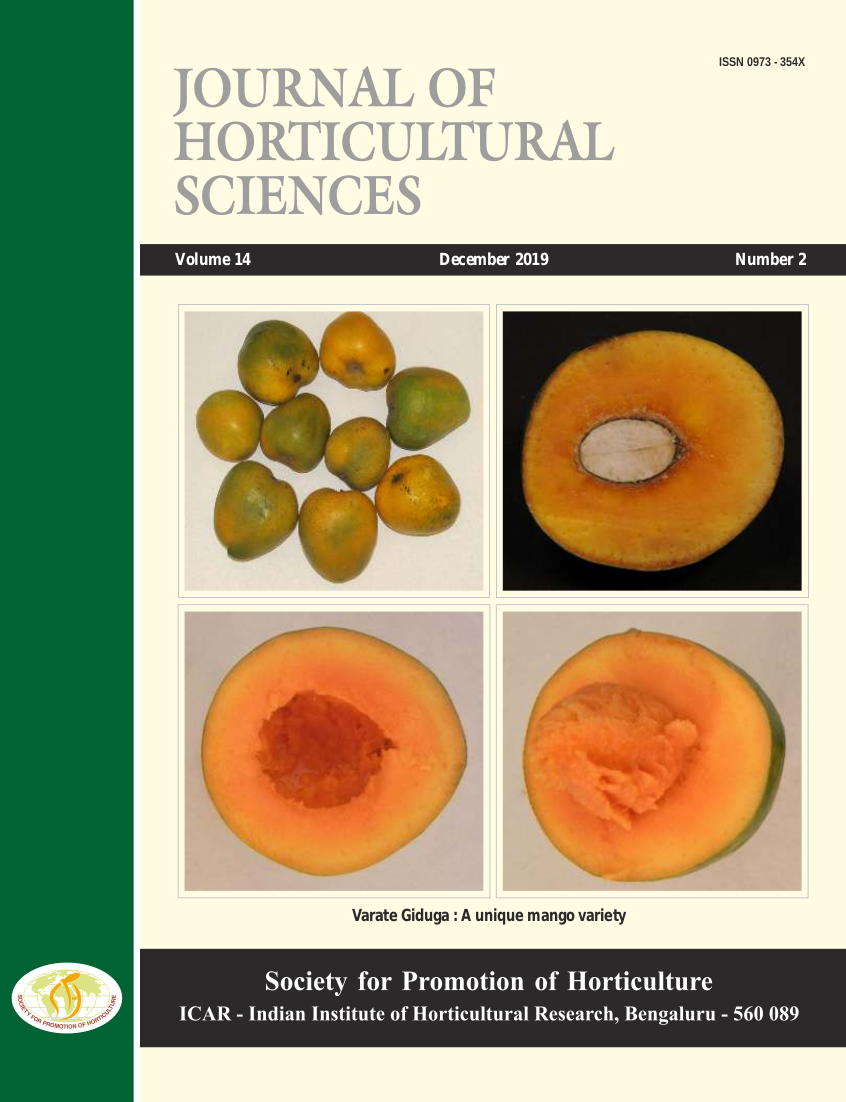Correlation of Leaf Parameters with Incidence of Papaya Ring Spot Virus in Cultivated Papaya and its Wild Relatives
DOI:
https://doi.org/10.24154/jhs.v14i2.796Keywords:
Epicuticular wax content, Papaya, Trichome density, VasconcelleaAbstract
Papaya ring spot virus (PRSV) disease has been the major impediment in papaya cultivation. The disease is transmitted through three aphid vectors and field tolerance towards this disease varies among Carica papaya cultivars as well as within the Vasconcellea genus. Leaf morphological traits are known to have influence on the probing preferences of aphids. Hence, this study was conducted to know whether the leaf parameters could contribute to the incidence of PRSV possibly by influencing the probing or feeding behaviour of aphid vectors. Leaf parameters viz., leaf thickness, leaf epicuticular wax content, presence and type of trichomes, trichome density were correlated with disease incidence at field conditions. The result revealed that leaf thickness along with epicuticular wax content had significant negative correlation with disease incidence. Similarly, trichome density had negative impact on disease incidence at 99.92% significance level. High epicuticular wax content and high trichome density in V. cauliflora and V. cundinamarcensis were found to be negatively associated with low to very low infection indicating that these parameters may have limited the vector transmission significantly.
Downloads
References
Bin, F. 1979. Influenza dei peli glandolari sugli insetti in Lycopersicon spp. Frust Ent., 15:271-283.
Kalleshwaraswamy, C.M and Krishnakumar, N.K. 2008. Transmission efficiency of Papaya ringspot virus by three aphid species. Phytopathology, 98(5):541-546. DOI: https://doi.org/10.1094/PHYTO-98-5-0541
Dinesh, M.R. 2010. Papaya breeding in India. Acta Hort., 851: 69-75 DOI: https://doi.org/10.17660/ActaHortic.2010.851.7
Ebercon, A., Blum, A and Jordan, W.R. 1977. A rapid colorimetric method for epicuticular wax content of sorghum leaves. Crop Sci., 17: 179-180. DOI: https://doi.org/10.2135/cropsci1977.0011183X001700010047x
Goffreda, J.C., Mutschler, M.A., Ave´ D.A., Tingey, W.M and Steffens, J.C. 1989. Aphid deterrence by glucose estersin glandular trichome exudate of the wild tomato, Lycopersicon pennellii. J Chem Ecol.,15:2135-2147. DOI: https://doi.org/10.1007/BF01207444
Guerrieri, E and Digilio, M.C. 2008. Belowground mycorrhizal endosymbiosys and aboveground insects: Can multilevel interactions be exploited for a sustainable control of pests? Molecular mechanisms of plant and microbe coexistence. DOI: https://doi.org/10.1007/978-3-540-75575-3_5
In: Nautiyal CS, Dion P, editors. Heidelberg: Springer-Verlag. p. 125-152.
Musetti, L and Neal, J.J. 1997. Resistance to the pink potato aphid, Macrosiphum euphorbiae, in two accessions of Lycopersiconhirsutum f. glabratum. Entomol Exp Appl., 84:137-146. DOI: https://doi.org/10.1046/j.1570-7458.1997.00208.x
Ostrand, F., Wallis, I.R., Davies, N.W., Matsuki, M and Steinbauer, M.J. 2008. Causes and consequences of hostexpansion by Mnesamela privata. J. Chem.Ecol.,34: 153-167. DOI: https://doi.org/10.1007/s10886-007-9422-y
Shepherd, T., Robertson, G.W., Griffiths, D.W and Birch, A.N.E.1999. Epicuticular wax ester and triacyloglycerol compositionin relation to aphid infestation and resistance in red raspberry (Rubus idaeus L.). Phytochemistry.52: 1255-1267. DOI: https://doi.org/10.1016/S0031-9422(99)00414-8
Wang, E., Hall, J.T and Wagner, G.J. 2004. Transgenic Nicotiana tabacum L. with enhanced trichome exudates cembratrieneols has reduced aphid infestation in the field. Mol. Breed. 13: 49-57 DOI: https://doi.org/10.1023/B:MOLB.0000012328.04974.fb
Wojcicka, A. 2015. Surface waxes as a plant defense barrier towards grain aphid. Acta Biologica Cracoviensia Series Botanica.57(1): 95-103. DOI: https://doi.org/10.1515/abcsb-2015-0012
Downloads
Published
Issue
Section
License
Copyright (c) 2019 Linta Vincent, Soorianathasundaram K, Shivashankara K S (Author)

This work is licensed under a Creative Commons Attribution-NonCommercial-ShareAlike 4.0 International License.
Authors retain copyright. Articles published are made available as open access articles, distributed under the terms of the Creative Commons Attribution-NonCommercial-ShareAlike 4.0 International License, which permits unrestricted non-commercial use, distribution, and reproduction in any medium, provided the original author and source are credited. 
This journal permits and encourages authors to share their submitted versions (preprints), accepted versions (postprints) and/or published versions (publisher versions) freely under the CC BY-NC-SA 4.0 license while providing bibliographic details that credit, if applicable.





 .
. 











